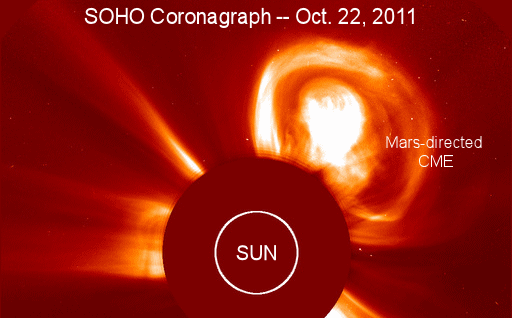Особенности магнитной бури на Марсе
24-10-2011, 11:58. Разместил: VP
 |
Вечером 22 октября из группы пятен 1314 произошел интенсивный выброс солнечной плазмы, который движется в направлении Марса. Эксперты считают, что поток жесткого излучения достигнет Красной планеты 26 октября. Марс, в отличие от Земли, не имеет сплошного магнитного поля. Когда-то оно было, но миллиарды лет назад распалось и теперь планета неравномерно покрыта десятками «магнитных зонтиков». При ударе заряженных частиц в них возникают магнитные бури и зажигаются полярные сияния. Поскольку структура магнитного поля неоднородна, то полярные сияния могут появиться даже на экваторе.
SPACE WEATHER FORECAST FOR MARS: A bright CME blasted off the sun yesterday, Oct. 22nd, and it appears to be heading for Mars. Analysts at the Goddard Space Weather Lab expect the cloud to reach the Red Planet on Oct. 26th (forecast track). A brief discussion of what CMEs can do to Mars follows this SOHO image of the eruption:
Mars has a unique response to solar storms shaped by the planet's strange magnetic topology. Unlike Earth, which has a global magnetic field, Mars is patchily covered by dozens of "magnetic umbrellas"--remnants of an over-arching planetary field that decayed billions of years ago. When Mars gets hit by a CME, the resulting magnetic storms take place in the umbrellas. Circumstantial evidence collected by Mars Global Surveyor in the 1990s suggests that the tops of the umbrellas light up with bright ultraviolet auroras during such storms. Because the structures are distributed around the planet, these auroras can appear even at the equator.
Mars rovers and satellites should be alert for aurora equatoralis on Oct. 26th.
Bonus: Magnetic umbrellas are at the heart of one of Mars's greatest mysteries: What happened to the atmosphere? Billions of years ago, the air on Mars was thick enough to protect vast expanses of water on the planet’s surface. Now, however, the atmosphere is 100 times thinner than Earth's and the surface is bone dry. Some researchers believe that magnetic storms in the umbrellas could rip parcels of atmosphere away from Mars and propel air-filled magnetic bubbles into space. In this way, space weather could be directly responsible for the desiccation of the Red Planet.
http://spaceweather.com/
Вернуться назад
